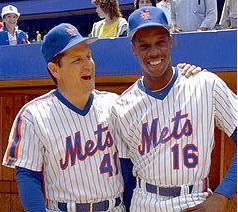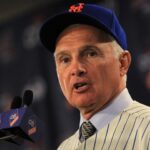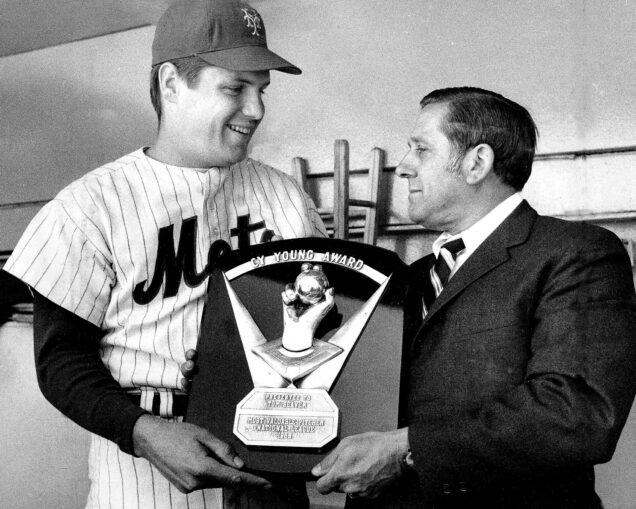
“Nobody likes to hear it, because it is dull, but the reason you win or lose is darn near always the same–pitching.” –Earl Weaver
Even if the above quote didn’t include his patented ‘three-run homer’ in addition to his recipe for success, the point is as well taken as it is obvious — a teams’ pitching is what makes or breaks a season.
Perhaps no team in the majors has seen its fortunes rise and fall based on its starting pitching more than the New York Mets — an organization well-known for it’s developing, trading for, and signing top-flight pitchers.
Scarcely seven years after their inception in 1962, the Mets had a Cy Young winner. Mets starters have garnered that esteemed award seven times.
Even before that, they had their first of four Rookies of the Year who were pitchers. The All-Star game has had a Met pitcher in exactly half the 58 seasons the Mets have played, far and away the most frequent position represented.

The Mets even had an ERA champion in 1978 — Craig Swan, who led the NL with a 2.43 ERA.
He goes largely unnoticed, however, due to the accomplishments of others and the frequency at which Mets pitchers have dominated in earned run average over the years.
While the Mets have only had one batter in franchise history with an OPS over 1.000 (Mike Piazza in 2000), they have had a cadre of award-winning pitchers who have become synonymous with the name Mets.
Some include:
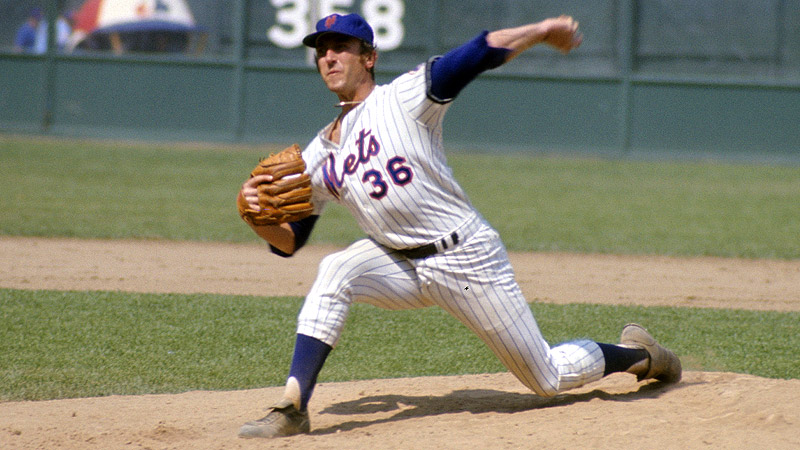
Tom Seaver, Jerry Koosman and Jon Matlack (and even Nolan Ryan for awhile) in the late ‘60s and ‘70s, to Dwight Gooden, Ron Darling, Sid Fernandez, and David Cone in the ‘80s.
The brief dominance of Al Leiter in the late ’90s, then on to the deGrom/Harvey/Syndergaard group of recent years — this franchise has had more than its share of golden arms during its relatively brief 58-year history.
There have been others that have had great individual years (Pedro Martinez or Johan Santana come to mind), some of which will be cited in the honorable mentions at the end.
So now we are tasked with the unenviable, but certainly privileged duty to name the five best seasons a Mets pitcher has ever had.
Some of the campaigns listed are among the very best seasons a big-league pitcher has ever had. First, some bookkeeping: there are other ‘five or ten best lists’ of Mets pitching campaigns that exclude the greatest Met, Tom Seaver.
While acknowledging his greatness, the feeling was that any list would simply be an ode to the magnificence of the man they call ‘the Franchise’ and give little respect to other pitchers in Mets history.
This list — includes Seaver. It is inconceivable to write about Mets pitching without including the greatest of them all. And yes, three of the five best seasons belong to Tom Terrific.
Also, the make-up of the five seasons is largely based on statistics, but not solely. You can’t put a stat on the importance Seaver had on the 1969 Mets, both on the field and off — leading to the most unlikely of World Championships.
Yet, the ’69 season is only Seaver’s fourth best in ERA and WAR. Yet, it lands in the two spot here. Let the debate begin.
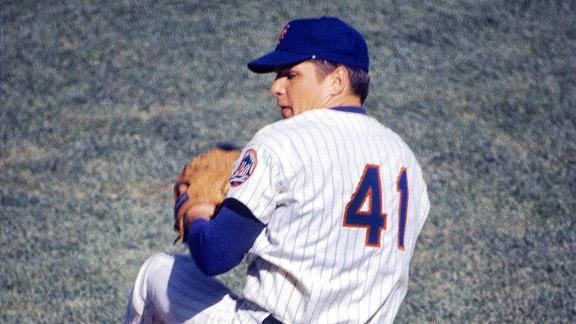
5. Tom Seaver—1973
“I really didn’t think I’d win it. I was really surprised,” Seaver told United Press International.
“I thought it would be between (Ron) Bryant and (Mike) Marshall, because of the 19 wins and I figured I hadn’t done enough. But a lot of people remembered what I had done earlier in the season.”
In 1973, Seaver won the second of his Cy Young Awards in somewhat of a surprise, even to him. It was the first time a Cy Young had been given to a pitcher with less than 20 wins.
Seaver took home the NL Cy Young following a 19-10 campaign that saw him lead the National League in earned-run average (2.08), FIP (2.57), complete games (18) and strikeouts (251).
His 10.6 bWAR was the highest single season mark in his career.
Seaver was 15-6 with a 1.78 ERA on August 15, but went 4-4 down the stretch as his workload – which reached 290.0 innings that year – began to take its toll.
Still, Seaver made four starts combined in the NLCS and World Series that year, striking out 35 batters in 31.2 innings and leading the Mets to within one game of the title.
“I’m very, very happy about winning the award because of the name that’s on it and what it means: The best pitcher in the National League,” Seaver said.
“Sure I’m disappointed I wasn’t effective down the stretch. But I thought I pitched exceptionally well up until the last few weeks of the season when the amount of work and fatigue caught up with me.”
“In fact, I felt that I pitched better than ever before in my career. But I still get to the point where I think I can do more than I can.”
In a time where wins were considered king, it was nice to see the writers recognize Seaver for the competitor he was. He bucked the trend in 1973, and deservedly took home the hardware as the best pitcher in the NL.
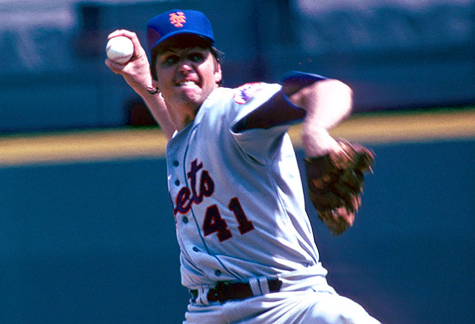
4. Tom Seaver—1971
Seaver’s best statistical season was, oddly, in a year he did not win a Cy Young, but finished second.
The Mets were not a particularly good team in 1971, going 83-79 and finishing 14 games behind the division champs — the Pittsburgh Pirates.
Seaver certainly did his part going 20-10 with 289 strikeouts in 1971 — the most K’s he ever amassed in a single year.
The same is true of the 1.78 ERA and 0.94 WHIP. His 10.2 WAR was topped only once — in 1973 when Seaver posted a 10.6 WAR.
The season included 13 double-digit strikeout performances by Seaver, twice fanning a season-high 14. He completed 21 games and had four shutouts.
However, Seaver ultimately finished second in Cy Young voting to Ferguson Jenkins of the Chicago Cubs, who had 24 wins with just 37 walks in 39 starts and 325 innings pitched.
On the other hand, Jenkins’ ERA that year was 2.77, compared to Seaver’s 1.76. That 1.76 ERA is the third lowest by a starter in Mets history.
With today’s emphasis on sabermetrics helping look past just the ‘wins’ statistic, Seaver might have won the Cy Young. We will never know, even though some debate the point to this day.
What is not debatable is the excellence of Tom Terrific’s 1971 campaign and his incredible near 300-strike out season.
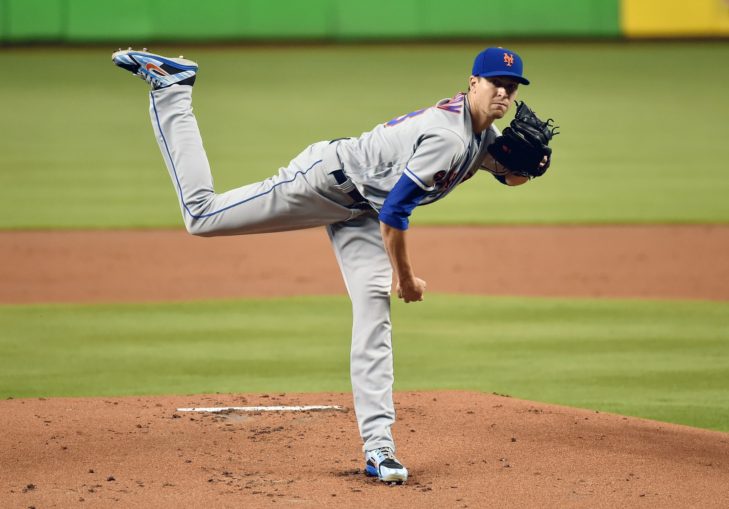
3. Jacob deGrom—2018
Author of one of the greatest mound performances in MLB history, Jacob deGrom comes in at number three on the list — and if it weren’t for a special once in a millennial year in 1969 — would be number two.
For most franchises, he’d be number one by a large margin — his 2018 season was that dominant.
First the numbers: deGrom went 10-9 with a league leading 1.70 ERA (1.98 FIP, which also led the league), 217 IP, 269 strikeouts, a .912 WHIP, and a 218 ERA+ — the 20th best ERA+ of all time.
He became only the third pitcher since 1908 to strike out over 200, have an ERA of below 2.00, and walk fewer than 50 batters.
DeGrom finished the year with 32 games started. Since lowering the mound for the 1969 season, only two pitchers have made at least 30 starts, or pitched at least 210 innings, with an ERA as low as deGrom’s.
He ended the season on a run of 29 straight starts allowing three runs or fewer. That’s the longest single-season streak in MLB history, tied with Jake Arrieta for the longest streak overall (doing so from ’15-’16).
Further — deGrom’s last 24 starts were all quality-starts, which is the longest single-season streak in MLB history and third longest overall.
Of course, part of deGrom’s story this season was his egregious lack of run support. Of his MLB-high 13 starts in which he pitched at least seven innings and allowed no more than one run — he was not credited with a win in eight of them.
That doubled the total of any other MLB pitcher, and tied for the most by any pitcher in a season since at least 1908, with Roger Craig of the ’63 Mets.
If the Mets hit just to their season’s average, deGrom would have won well over 20 games.
There’s much more to the 2018 deGrom season, but suffice it to say it wasn’t bad for a player who made his MLB debut at 25, recovered from Tommy John surgery while in the minors, and was expected to be only the third best pitcher in the Matt Harvey/Noah Syndergaard/Jacob deGrom triad of pitchers.
As of the summer of 2020, deGrom is a two-time Cy Young winner, three-time All-Star and Rookie of the Year winner in 2014.
He holds the major league record with 30 straight starts allowing three-runs or fewer.
On a team that has had names like Seaver, Gooden, Santana, Matinez, Koosman, Cone and so many others — Jacob deGrom’s 2018 season is right there as the finest ever and more than worthy to be included on this exclusive list.

2. Tom Seaver—1969
Depending on how one measures the quality of a pitcher’s season, Tom Seaver’s 1969 campaign can rank anywhere on this list or not even be on it.
After all, there were four other seasons where Seaver pitched to a better ERA and WAR than in 1969. Yet, he lands in the runner-up spot as the best season a Mets pitcher has ever had.
It is the year Seaver is defined by, culminating in a glorious championship many regard as the highlight moment of the Mets franchise.
The measurable stats were excellent for Seaver — going 25-7 with a 2.21ERA, 208 Ks in 273.1 IP and a 1.039 WHIP.
The 25 wins led the NL and is still a Mets franchise record.
He won his first of three Cy Young awards, made his third of a remarkable 12 All-Star Games appearances, and was a close second to Willie McCovey in MVP voting in ’69.
At year’s end, Seaver was presented with the Hicock Belt as the top professional athlete of the year and won Sports Illustrated magazine’s “Sportsman of the Year” award.
As impressive as his stats were, it was the unmeasurable qualities that lifted Tom Terrific and ultimately his team. During the regular season, Seaver had a streak of 13 wins in 14 starts from April 30 until July 9.
Then, he won his last ten starts pitching to a spectacular 1.34 ERA down the stretch. He gutted out an NLCS win against the Atlanta Braves before losing game 1 of the World Series.
Undeterred, Seaver took the ball in game four and pitched a 10-inning complete-game win to give the Mets a solid 3-1 series lead.
The point is that Tom Seaver showed qualities not found in a box score or a web page. He put the team on his back and willed them to win — and they did.
Only special athletes can do that in any sport. His drive, tenaciousness, and heart won over a city that still loves him dearly today.
Plain and simple, without Seaver — there aren’t any “Miracle Mets”. That more than any definable statistic is the reason his 1969 season is his very best.
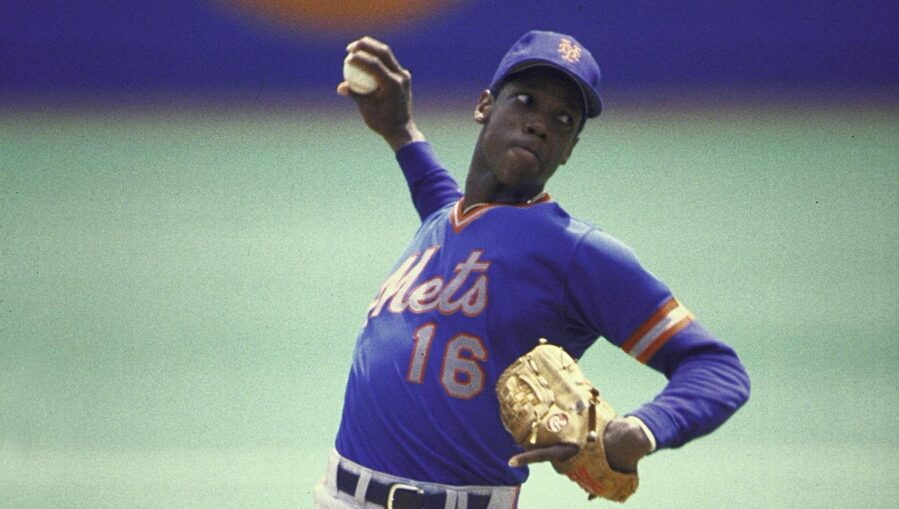
1. Dwight Gooden—1985
Dwight Gooden’s 1985 season is called by most pundits one of the top seasons of all time by a major league pitcher.
At just 20 years of age and in only his second year with the Mets, Gooden set single-season standards that may never be broken.
“Doc” or “Dr. K” as he was known went 24-4 in 1985 and pitched to a 1.53 ERA. He struck out 268 batters in 273.1 IP and walked only 60.
He had 18 complete games and five shut-outs. His WHIP was 0.965 and his ERA+, at 229 — is the 12th highest ERA+ in history.
What really cements this tremendous season was his insane 12.2 WAR, the highest such mark in the last 100 years.
Gooden won the pitching Triple Crown in 1985, leading the league in wins, strikeouts, and ERA. He was also first in FIP (2.13) and complete games.
His 1.53 ERA was the second lowest in the live-ball era.
From August 31 through September 16, Gooden threw 31 consecutive scoreless innings over four games, and through October 2 –threw 49 consecutive innings over seven games without allowing an earned run.
Dwight Gooden won the Cy Young Award and Pitcher of the Year in 1985, the youngest player to win either. He also made the second of his four All-Star appearances in 1985.
To further gauge Goodens’ dominance over about a year and a half period: in 50 starts from August 11, 1984, to May 6, 1986, Gooden posted a record of 37–5 with a 1.38 ERA — with 412 strikeouts and 90 walks in 406 innings. Perhaps the finest stretch a pitcher has ever had in the history of the game.
Truly a young master, his career going forward would be marked by bumps in the road known by all.
But this isn’t about bumps, it’s about brilliance and for one year, Dwight Gooden was among the most brilliant at his craft that there ever was.
He tops a rarefied list filled with legendary players to rightfully earn the title as having the best season a Mets starting pitcher has ever had.
Honorable Mentions
Another baker’s dozen of fine pitchers not mentioned above that could have easily made the top five list on other teams, but were just short with the Mets:
Jerry Koosman—1969
Jon Matlack—1974
Craig Swan—1978
David Cone—1988
Frank Viola—1990
Sid Fernandez—1992
Bret Saberhagen—1994
Al Leiter—1998
Pedro Martinez—2005
Johan Santana—2008
R.A. Dickey—2012
Matt Harvey—2013
Noah Syndergaard—2016


